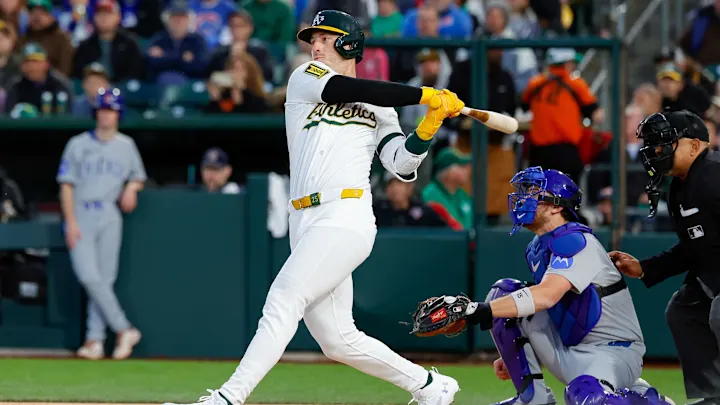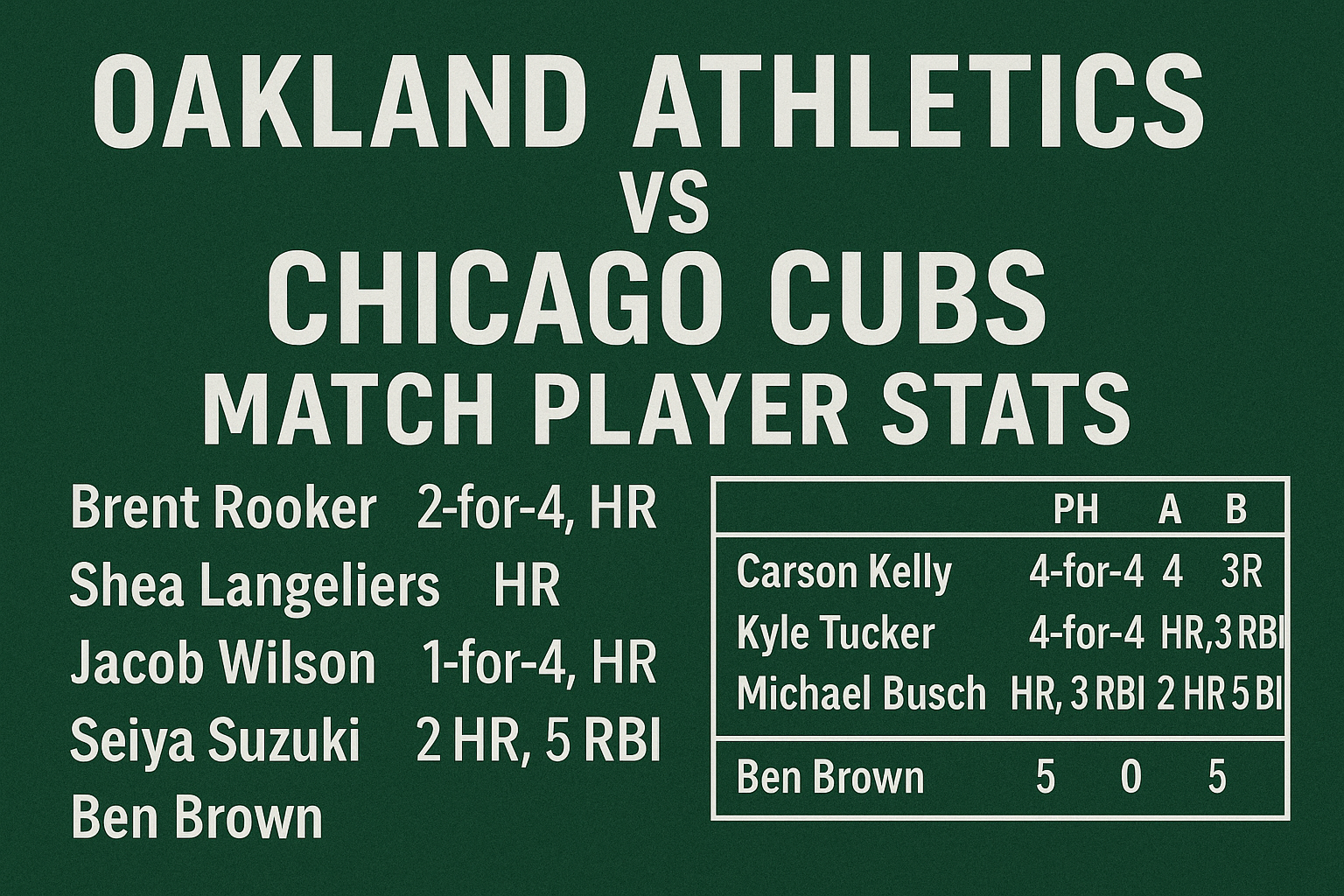The Oakland Athletics vs Chicago Cubs match player stats have drawn attention from baseball fans after a powerful sweep by the Cubs in the 2025 series held in West Sacramento. Across the three-game faceoff from April 1 to April 3, the Chicago Cubs dominated offensively and defensively, leaving little space for the A’s to respond. The final game scores told the story: 18–3 in Game 1, 7–4 in Game 2, and 10–2 in Game 3, giving the Cubs a clean sweep and adding to their strong early-season form.
These games not only highlighted big names like Carson Kelly, Kyle Tucker, and Seiya Suzuki, but also showed how team chemistry and pitching depth can crush even hopeful home openers like the A’s. The series was played at Sutter Health Park, which temporarily hosts the A’s due to stadium transitions. Despite their home advantage, Oakland struggled to gain momentum in any part of the series.
The Cubs’ victory was not accidental. It reflected strong planning, efficient roster depth, and multiple players hitting top form at the right time. The Cubs now maintain a perfect 9–0 road record against the A’s since 2016, continuing a trend of dominance that goes beyond just one series. For Oakland, this series underlined gaps in pitching endurance and lack of clutch hitting, even as some young prospects gave glimmers of promise.
This post provides a detailed and simple breakdown of every match moment, player performance, and meaningful stat from this series. Whether you’re a stats lover or just curious about who shined, this breakdown brings clarity to the entire Cubs vs A’s matchup.
Table of Contents
Box Score & Team Stats Comparison
To understand the Oakland Athletics vs Chicago Cubs match player stats, we must look closely at the numbers behind the series. The box scores of each game reveal the Cubs’ explosive offense and tight pitching, while also showing the A’s lack of consistency in scoring and pitching control.
Team Comparison Table (Series Totals)
| Team | Runs | Hits | Home Runs | Errors | Strikeouts (Pitching) |
|---|---|---|---|---|---|
| Chicago Cubs | 35 | 39 | 8 | 1 | 28 |
| Oakland Athletics | 9 | 21 | 3 | 3 | 17 |
- The Cubs scored an average of over 11 runs per game, showing their offensive power.
- Oakland’s hitters produced just 3 home runs over three games, compared to 8 by Chicago.
- The A’s committed more errors, highlighting their defensive issues, especially under pressure.
- Cubs pitchers struck out 28 batters in the series, showing command on the mound.
This comparison shows how every part of Chicago’s game—offense, defense, and pitching—was sharper than Oakland’s across the board.

Top Performers – Chicago Cubs Batter Stats
The Cubs lineup was on fire in this series, with multiple players delivering standout performances in each game.
Game-by-Game Key Batting Highlights:
Game 1: Cubs 18, Athletics 3
- Carson Kelly made history by hitting for the cycle (single, double, triple, home run), going 4-for-4 with 3 RBIs and a walk. It was the first Cubs cycle since 1993.
- Kyle Tucker went 4-for-4 with 3 runs scored, 1 homer, and 3 RBIs.
- Michael Busch added a homer and 3 RBIs.
- Dansby Swanson also homered, with 3 RBIs of his own.
Game 2: Cubs 7, Athletics 4
- Seiya Suzuki smashed a three-run homer in the first inning, and added another solo shot later, totaling 5 RBIs.
- Pete Crow-Armstrong and Nico Hoerner combined for four hits and aggressive baserunning that pressured the A’s defense.
Game 3: Cubs 10, Athletics 2
- Suzuki continued his hot streak, adding another home run, and finishing the series with 3 HR and 8 RBIs.
- Matt Shaw added 2 hits, showing promise as a utility infielder with power potential.
These games were a showcase of depth and balance in the Cubs’ batting order. Multiple players contributed, making it hard for A’s pitchers to find a weak link.
Top Performers – Oakland Athletics Batter Stats
Although the Oakland Athletics were clearly outplayed, a few names stood out with individual moments of brilliance, especially from young talents and power hitters.
- Brent Rooker provided the most reliable offense for the A’s. He hit home runs in both Game 1 and Game 2, showing why he’s one of Oakland’s most dangerous hitters.
- Jacob Wilson, one of Oakland’s top young prospects, hit his first career MLB home run in Game 1. He also extended his early-season hit streak, a sign of his rising importance.
- Shea Langeliers, though quiet in this series, had a big history vs the Cubs in past seasons and showed signs of good plate discipline.
The issue was not the individual talents, but the inability to chain hits together. Oakland left too many runners on base and failed to convert chances, while Chicago did the opposite.
Pitching Performances & Bullpen Analysis
Pitching was a major difference in this series. Cubs pitchers dominated, while the A’s staff crumbled under pressure.
Cubs Starting Pitchers:
- Ben Brown (Game 1): 5 IP, 6 H, 3 R, 5 K – steady control, got early run support.
- Justin Steele (Game 2): 6.2 IP, 4 H, 4 R (2 earned), 6 K – survived a tough middle innings but got the job done.
- Jameson Taillon (Game 3): 6 IP, 3 H, 2 R, 7 K – efficient and aggressive, commanding the mound.
Cubs Bullpen (Series Total):
- Combined for 8 scoreless innings across the series.
- Julian Merryweather, Ryan Pressly, and Luke Little were key relievers, keeping Oakland bats quiet.
Athletics Pitchers:
- Luis Severino (Game 1): Gave up early runs and couldn’t slow down the Cubs momentum.
- Jeffrey Springs (Game 3): Allowed key home runs to Suzuki and struggled with location.
- The bullpen was stretched thin, and no reliever stood out positively.
The pitching imbalance was critical. Cubs starters were consistent and supported by a rested, effective bullpen. Oakland’s arms lacked rhythm and composure once under pressure.
May You Like This: chicago cubs vs baltimore orioles match player stats
Stat Lines & Advanced Metrics Breakdown
Let’s dig into some player-specific stats to highlight just how impactful some of the Cubs stars were in this series.
Cubs Key Player Stats (Series Totals)
| Player | AVG | HR | RBI | OPS |
|---|---|---|---|---|
| Seiya Suzuki | .545 | 3 | 8 | 1.670 |
| Carson Kelly | .500 | 1 | 3 | 1.375 |
| Kyle Tucker | .500 | 1 | 4 | 1.420 |
| Michael Busch | .375 | 1 | 3 | 1.080 |
Athletics Key Player Stats
| Player | AVG | HR | RBI | OPS |
|---|---|---|---|---|
| Brent Rooker | .333 | 2 | 4 | 1.200 |
| Jacob Wilson | .286 | 1 | 1 | .925 |
Cubs players not only had strong average numbers, but also high OPS (on-base plus slugging), showing how often and how powerfully they contributed. Oakland had moments, but couldn’t sustain them.
Record & Streak Insights (H2H & Trends)
Historically, the Cubs have dominated recent matchups against the Athletics. This 2025 series sweep continued a winning streak that started in 2016.
Cubs vs Athletics – Last 3 Road Series (All Sweeps)
- 2016: Cubs swept 3-0 in Oakland.
- 2023: Cubs again swept 3-0 at the Coliseum.
- 2025: Now 3-0 in Sacramento.
That’s 9 straight road wins for the Cubs over the A’s, with most games won by wide margins. It’s a rare example of one team clearly owning the other, especially when playing away.
Reader Q&A – FAQs
Q1: Who had the most RBIs in the series?
Seiya Suzuki led with 8 RBIs.
Q2: Did anyone hit a cycle?
Yes, Carson Kelly hit for the cycle in Game 1.
Q3: Who pitched best for the Cubs?
Jameson Taillon had the cleanest start with 7 strikeouts.
Q4: Which A’s player hit a home run?
Brent Rooker and Jacob Wilson both homered.
Q5: What was the final series score?
Cubs swept: 18-3, 7-4, 10-2.
Conclusion & Key Takeaways
The Oakland Athletics vs Chicago Cubs match player stats tell a clear story: Chicago was dominant in every area. The Cubs lineup exploded, the pitchers held firm, and the defense stayed clean. Meanwhile, Oakland saw flashes of talent, but not enough to match up. The 2025 series added another sweep to Chicago’s record in this matchup, making it clear they’ve found a formula that works.
This wasn’t just a victory; it was a complete performance. Suzuki, Kelly, and Tucker showed they can carry the Cubs through any challenge, and the pitching staff showed depth. For the A’s, this series raised questions about bullpen strength and lineup balance—but also gave hope in young players like Wilson.

